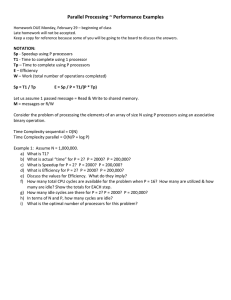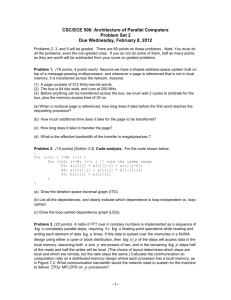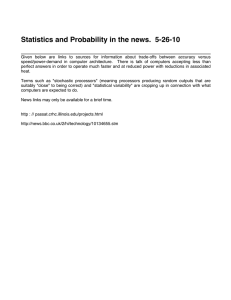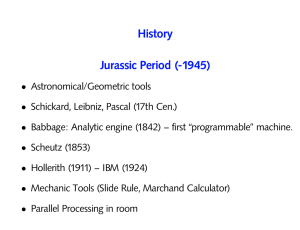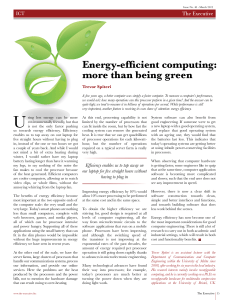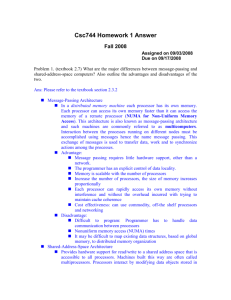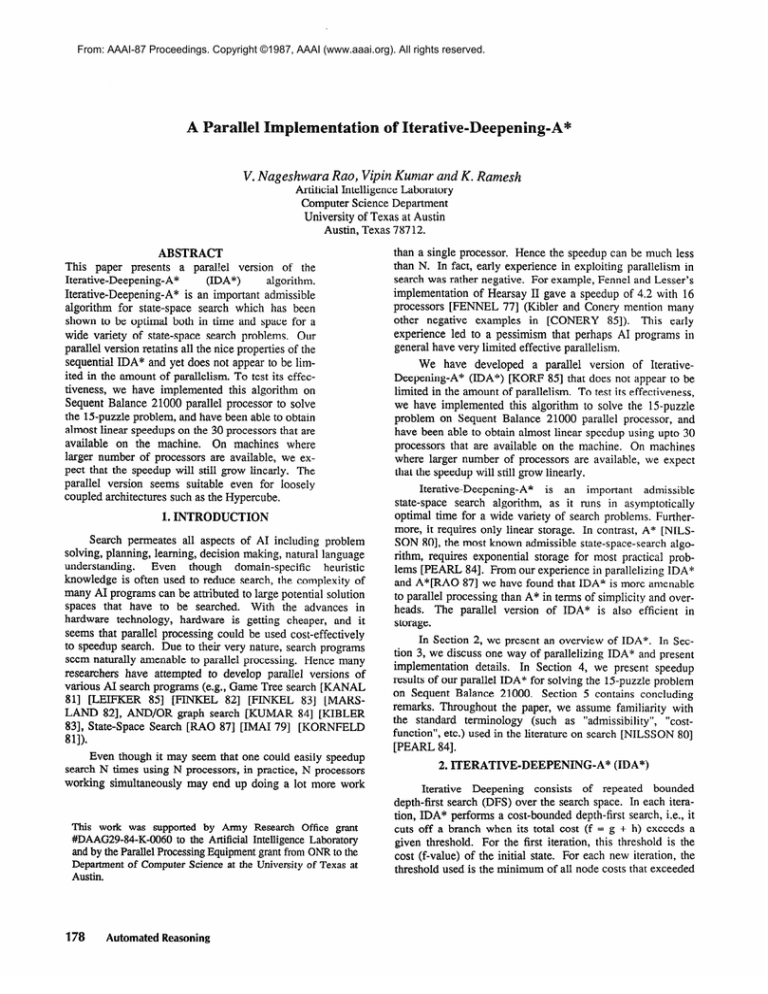
From: AAAI-87 Proceedings. Copyright ©1987, AAAI (www.aaai.org). All rights reserved.
V. Nageshwara Rao, Vipin Kumar and K. Ramesh
Artiticial Intelligence Laboratory
Computer Science Department
University of Texas at Austin
Austin, Texas 787 12.
ABSTRACT
This paper presents
a parallel version of the
Iterative-Deepening-A*
(IDA*)
algorithm.
Iterative-Deepening-A*
is an important admissible
algorithm for state-space
search which has been
shown to be optimal both in time and space for a
wide variety of state-space search problems.
Our
parallel version retatins all the nice properties of the
sequential IDA* and yet does not appear to be limited in the amount of parallelism. To test its effectiveness, we have implemented
this algorithm on
Sequent Balance 21000 parallel processor to solve
the 15-puzzle problem, and have been able to obtain
almost linear speedups on the 30 processors that are
available on the machine.
On machines where
larger number of processors are available, we expect that the speedup will still grow linearly. The
parallel version seems suitable even for loosely
coupled architectures such as the Hypercube.
1. INTRODUCTION
Search permeates all aspects of AI including problem
solving, planning, learning, decision making, natural language
understanding.
Even
though
domain-specific
heuristic
knowledge is often used to reduce search, the complexity of
many AI programs can be attributed to large potential solution
spaces that have to be searched.
With the advances in
hardware technology,
hardware is getting cheaper, and it
seems that parallel processing could be used cost-effectively
to speedup search. Due to their very nature, search programs
seem naturally amenable to parallel processing.
Hence many
researchers have attempted to develop parallel versions of
various AI search programs (e.g., Game Tree search [KANAL
811 [LEIFKER 851 [FINKEL 821 [FINKEL 831 [MARSLAND 821, AND/OR graph search [KUMAR 841 [KIBLER
831, State-Space Search [RAO 871 [IMAI 791 [KORNFELD
811).
Even though it may seem that one could easily speedup
search N times using N processors, in practice, N processors
working simultaneously
may end up doing a lot more work
This work was supported by Army Research Office grant
#DAAG29-84-K-0060 to the Artificial Intelligence Laboratory
and by the Parallel Processing Equipment grant from OMR to the
Department of Computer Science at the University of Texas at
Austin.
178
Automated Reasoning
than a single processor. Hence the speedup can be much less
than N. In fact, early experience in exploiting parallelism in
search was rather negative. For example, Fennel and Lesser’s
implementation
of Hearsay II gave a speedup of 4.2 with 16
processors [FENNEL 771 (Kibler and Conery mention many
other negative examples
in [CONERY 851). This early
experience led to a pessimism that perhaps AI programs in
general have very limited effective parallelism.
We have developed
a parallel version of IterativeDeepening-A*
(IDA*) [KORF 851 that does not appear to be
limited in the amount of parallelism. To test its effectiveness,
we have implemented
this algorithm to solve the 15-puzzle
problem on Sequent Balance 21000 parallel processor, and
have been able to obtain almost linear speedup using upto 30
processors that are available on the machine. On machines
where larger number of processors are available, we expect
that the speedup will still grow linearly.
Iterative-Deepening-A*
is an important
admissible
state-space
search algorithm, as it runs in asymptotically
optimal time for a wide variety of search problems. Furthermore, it requires only linear storage. In contrast, A* [NILSSON 801, the most known admissible state-space-search
algorithm, requires exponential storage for most practical problems [PEARL 841. From our experience in parallelizing IDA*
and A*k[RAO 871 we have found that IDA* is more amenable
to parallel processing than A* in terms of simplicity and overheads. The parallel version of IDA* is also efficient in
storage.
In Section 2, we present an overview of IDA*. In Section 3, we discuss one way of parallelizing IDA* and present
implementation
details. In Section 4, we present speedup
results of our parallel IDA* for solving the 15-puzzle problem
on Sequent Balance 21000. Section 5 contains concluding
remarks. Throughout the paper, we assume familiarity with
the standard terminology
(such as “admissibility”,
“costfunction”, etc.) used in the literature on search [NILSSON 801
[PEARL 841.
2.
ITERATIVE-DEEPENING-A”
(IDA*)
Iterative
Deepening
consists
of repeated
bounded
depth-first search (DFS) over the search space. In each iteration, IDA* performs a cost-bounded depth-first search, i.e., it
cuts off a branch when its total cost (f = g + h) exceeds a
given threshold.
For the first iteration, this threshold is the
cost (f-value) of the initial state. For each new iteration, the
threshold used is the minimum of all node costs that exceeded
the (previous) threshold in the preceding iteration. The algorithm continues until a goal is expanded. If the cost function is
admissible,
then IDA* (like A*) is guaranteed to find an
optimal solution.
For exponential tree searches, IDA* expands asymptotically the same number of nodes as A*. It is quite clear that
the storage requirement of IDA* is linear with respect to the
depth of the solution. For a detailed description of IDA* and
its properties, the reader is referred to [KORF 851. In the following figure we give an informal description of IDA*.
Fig. 1
IDA*(startstate,h,movegen)
/* h is an admissible heuristic function for the problem */
/* movegen(state,fun)
generates all sons of state and returns
them ordered according to heuristic function fun.
Such an ordering is not essential for admissibility, but
may improve performance in last iteration
*/
/* cb is cost bound for current iteration
“I
/* nextcb is cost bound for next iteration
*/
nextcb = h(startstate) ;
while (not solutionfound)
cb = nextcb ;
nextcb = +m ;
PUSH(startstate,movegen(startstate,h))
depth = 1 ;
while (depth > 0)
We parallelize IDA* by sharing the work done in each
iteration ( i.e., cost-bounded
depth-first
search) among a
number of processors.
Each processor searches a disjoint part
of the cost-bounded
search space in a depth-first fashion.
When a process has finished searching its part of the (costbounded) search space, it tries to get an unsearched part of the
search space from the other processors.
When the costbounded search space has been completely searched, the processors detect termination of the iteration and determine the
cost bound for the next iteration. When a solution is found, all
of them quit.
Since each processor searches the space in a depth-first
manner,
the (part of) state-space
available
is easily
represented by a stack (of node-children pairs) such as the one
used in IDA* (see Fig. 1). Hence each processor maintains its
own local stack on which it performs bounded DFS. When the
local stack is empty, it demands work from other processors.
In our implementation,
at the start of each iteration, all the
search space is given to one processor, and other processors
are given null space (i.e., null stacks). From then on, the
state-space
is divided
and distributed
among
various
processors.
in each of the processors
is
Fig. 2
if there are no children in the TOP element of the stack
“/
PROCESSOR(i)
while (not solutionfound)
if work is available in stack[i]
perform Bounded DFS on stack[i] ;
else if (GETWORK = SUCCESS )
continue ;
else if (TERMINATION
Qurr;
PUSH(nextchild,movegen(nextchild,h))
/* ADVANCE
depth = depth + 1 ;
;
*/
else
nextcb = MIN(nextcb,nextchild.cost)
3.1 Basic Concepts
The basic driver routine
given in Fig. 2.
;
POP ;
/* BACKTRACK
depth = depth - 1 ;
else
remove nextchild from TOP ;
if (nextchild.cost
I cb)
if nextchild is a solution
solutionfound = TRUE ;
3. A PARALLEL VERSION OF IDA” (PPDA”)
;
= TRUE)
P determine cost bound for the next iteration */
cb=MIN
[ nextcb[k] / 1 SklN
};
/* k varies over set of processors */
initialize stack depth,cb and nextcb
for the next iteration
{ End of Fig. 2 }
P POP, PUSH and TOP are operations on the DFS stack */
/* The elements of the stack are state-children pairs */
/* The children are ordered according to h. This ensures that
the the children of a node are explored in increasing h order */
P The cost function used is f(n) = g(n) + h(n) */
{ End of Fig. I}
Since the cost bounds for each iteration of PIDA* are
identical to that of IDA*, the first solution found by any processor in PIDA* is an optimal solution. Hence all the processors abort when the first solution is detected by any processor.
Due to this it is possible for PIDA* to expand fewer or more
nodes than IDA* in the last iterationl, depending upon when a
solution is detected by a processor. Even on different runs for
solving the same problem, PIDA* can expand different
number of nodes in the last iteration, as the processors run
asynchronously.
If PIDA* expands fewer nodes than IDA* in
the last iteration, then we can observe speedup of greater than
Rao, Kumar,and Ramesh
179
if nextchild is a solution
N using N processors.
This phenomenon (of greater than N
speedup on N processors) is referred to as acceleration anomaly [LA1 831. In PIDA* at least one processor at any time is
working on a node n such that everything to the left of n in the
(cost bounded) tree has been searched. Suppose IDA* and
PIDA* start an iteration at the same time with the same cost
bound. Let us assume that IDA* is exploring a node n at a
certain time t. Clearly all the nodes to the left of n (and none
of the nodes to the right of n) in the tree must have been
searched by IDA* until t. It can be proven that if overheads
due to parallel processing (such as locking, work transfer, termination detection) are ignored, then PIDA* should have also
searched all the nodes to the left of n (plus more to the right of
n) at time t. This guarantees absence of deceleration anomaly
(i.e., speedup of less than 1 using N>l processors) for PIDA*,
as PIDA* running on N processors would never be slower
than IDA* for any problem instance.
3.2 Pmplementation Details.
As illustrated in Fig. 2, PIDA* involves three basic procedures to be executed in each processor:
(i) when work is
available in the stack, perform bounded DFS; (ii) when no
work is available, try to get work from other processors;
(iii)
when no work can be obtained try to check if termination has
occured. Notice that communication occurs in procedures (ii)
and (iii). The objective of our implementation is to see that (i)
when work is being exchanged, communication overheads are
minimized,
(ii) the work is exchanged between processors
infrequently;
(iii) when no work is available termination is
detected quickly. Fig. 3 illustrates the bounded DFS performed by ‘each processor. This differs slightly from bounded
DFS performed by IDA* (Fig. 1).
Fig. 3
Bounded DFS (startstack,movegen,h)
/* Work is available in the stack
and depth,
solutionfound
c?-Jn ;
PUSH[i] ( nextchild, movegen(nextson,
depth[i] = depth[i] + 1 ; /* ADVANCE
excdepth = MAX(depth[i]d,
h) ;
*/
excdepth[i])
;
nextcb[i] = MIN(nextcb[i],
nextson.cost)
;
{ End of Fig. 3 }
To minimize the overhead involved in transferring work
from one processor
to another, we associate a variable
excdepth[i] with the stack of processor i. The processor i
which works on stack[i] permits other processors to take work
only from below excdepth[i]. (We follow the convention that
the stack grows upwards).
The stack above excdepth[i] is
completely it’s own and the processor works uninterrupted
as
long as it is in this region. It can increment excdepth[i] at
will, but can decrement
it only under mutual exclusion.
Access to regions under excdepth[i] needs mutual exclusion
among all processors. A deeper analysis of the program in Fig
3 shows that this scheme gives almost unrestrained access to
each processor for it’s own stack.
The rationale behind keeping excdepth = depth/2 is to see that
only a fraction of the work is locked up at any time by processor i. In a random tree with branching factor b, if the stack i
has depth d then the fraction of work exclusively available to
processor i is l/(b**ld/21), which is quite small. But this work
is big enough for one processor so that it can keep .working for
a reasonable amount of time before locking the whole stack
again. This ensures that work is exchanged between processors infrequently.
cb,
Fig. 4
GETWORK
for (i = 0;j c NUMRETRY
increment
if there are no children in the
; j++)
target ;
if work is available at target below excdepth[target]
lock stack[target]
;
pick work from target.
unlock stack[target] ;
return (SUCCESS) ;
*/
return (FAIL) ;
else
remove nextson from TOP[i] ;
if ( nextchild.cost < cb )
* PIDA* expands exactly the same nodes as IDA* upto the last
but one iteration, as all these nodes have to be searched by both
PIDA* and IDA”.
180
Automated Reasoning
;
else
nextcb have
been properly initialized. */
excdepth[i] = -1 ;
while ((not solutionfound) and (depth > 0))
top element of the stack
POP ;
depth[i] = depth[i] - 1 ; /* BACKTRACK
if (depth c excdepth[i] )
lock stack[i] ;
excdepth[i] = depth[i]/2 ;
unlock stack[i] ;
= TRUE ;
send quit message to all other processors
/* When GETWORK picks work from target the work available in target stack is effectively split into 2 stacks. We need
to copy path information from startstate in order to allow later
computations
on the two stacks to proceed independently
*I
{ End of Fig. 4 }
The procedure GETWORK describes the exact pattern
of exchange of work between processors.
The processors of
the system are conceptualized
to form a ring. Each processor
maintains a number named target, the processor from which it
is going to demand work next time. (Initially target is the
processor’s neighbour in the ring). Starting at target, GETWORK ties to get work from next few processors in a round
robin fashion.
If no work is found after a fixed number of
retries, FAIL is returned.
The termination algorithm is the Ring termination algorithm of Dijkstra [DIJKSTRA $31. This algorithm suits our
implementation
very well and it is very efficient. Due to lack
of space, we omit the exact details of the algorithm here.
4. lPE
We implemented PIDA* to solve the 15-puzzle problem
on Sequent Balance 21000, a shared memory parallel processor. We ran our algorithm on all the thirteen problem
instances given in Korf’s paper [KORF 851 for which the
number of nodes expanded is less +han two million2. Each
problem was solved using IDA* on one processor, and using
PIDA* on 9,6 and 3 processors. As explained in the previous
section, for the same problem instance, PIDA* can expand
diffemt number of nodes in the last iteration on different runs.
Hence PIDA* was run 20 times in each case and the speedup
was averaged over 20 runs.
The speedup results vary from one problem instance to
another problem instance. For the 9 processor case, the average speedup for different problem instances ranged from 3.46
to 16.27. The average speedup over all the instances was 9.24
for 9 processors, 6.56 for 6 processors and 3.16 for 3 processors (Fig. 5). Even though for the 13 problems we tried, the
average speedup is superlinear (i.e., larger than N for N), in
general we expect the average speedup to be sublinear. This
follows from our belief that PIDA* would not in general
expand fewer nodes than IDA* (otherwise the time sliced version of PIDA* running on a single processor would in general
perform better than IDA*). Our results so far show that
PIDA* does not appear to expand any more nodes than IDA*
either. Note that the sample of problems we used in our experiment is unbiased (Korf generated these instances randomly).
Hence in general we can expect the speedup to be close to
linear.
To study the speedup of parallel approach in the absence
of anomaly, we modified IDA* and PIDA* (into AIDA* and
APIDA*) to find all optimal solutions. This ensures that the
search continues for all the search space within the costbound
of the final iteration in both AIDA* and APIDA*; hence both
AIDA* and APIDA* explore exactly the same number of
nodes. In this case the speedup of APIDA* is quite consistently close to N for N processors
for every problem
instance (Fig. 6). For 9 processors, the speedup is 8.4, for 6
processors it is 5.6, and for 3 processors it is 2.8 . We also
solved more difficult instances of 16-puzzle (requiring 8 to 12
million nodes) on a sequent machine with 30 processors.
As
2 Two million nodes was chosen as the cutoff, as the larger problems take quite a lot of CPU time. Besides, we were still able to get
13 problems, which is a reasonably large sample size.
shown in Fig. 6, the speedup grows almost linearly even upto
30 processors.
This shows that our scheme of splitting work
among different processors is quite effective. The speedup is
slightly less than N, because of overheads introduced by distribution of work, termination detection etc..
5. CONCLUDDG
REMARKS.
We have presented a parallel implementation
of the
Iterative-Deepening-A*
algorithm.
The scheme is quite
attractive for the following reasons. It retains all the advantages of sequential IDA*, i.e., it is admissible, and still has a
storage requirement linear in the depth of the solution. Since
parallel processors of PIDA* expand only those nodes that are
also to be expanded by IDA*, conceptually (i.e., discounting
overheads due to parallel processing,)
speedup should be
linear. Furthermore the scheme has very little overhead. This
is clear from the results obtained for the all solution case. In
the all solution case, both sequential and parallel algorithms
expand exactly the same number of nodes; hence any reduction in speedup for N (> 1) processors is due to the overheads
of parallel processing
(locking, work transfer, termination
detection, etc.). Since this reduction is small (speedup is
“0.93N for N upto 30), we can be confident that the overhead
of our parallel processing scheme is very low. The effect of
this overhead should come down further if PIDA* is used to
solve a problem (e.g. the Traveling Salesman Problem) in
which node expansions are more expensive.
Even on 15puzzle, for which node expansion is a rather trivial operation,
the speedup shows no sign of degradation upto 30 processors.
For large grain problems (such as TSP) the speedup could be
much more.
Even though we implemented PIDA* on Sequent Balance 21000 (which, being a bus based architecture, does not
scale up beyond 30 or 40 processors), we should be able to run
the same algorithm on different parallel processors such as
BBN’s Butterfly,
Hypercube
[SEITZ 851 and FAIM-1
[DAVIS 851. Parallel processors such as Butterfly and Hypercube can be easily built for hundreds of processors. Currently
we are working on the implementation of PIDA* on these two
machines.
The concept of consecutively bounded depth first search
has also been used in game playing programs [SLATE 771 and
automated deduction [STICKEL 851. We expect that the techniques presented in this paper will also be applicable in these
domains.
We would like to thank Joe Di Martin0 of Sequent Computer Corp. for allowing us the use of their 30-processor system for conducting experiments.
REFERENCES
[CONERY 851 Conery, J.S. and Kibler, D.F. , “Parallelism
CA1 -85, pp.53-56.
AI Programs”,
in
[DAVIS 851 Davis, A.L. and Robison, S.V. , “The A
ture of FAIM-1 Symbolic Multiprocessing
System”,
-85, pp.32-38.
Wao, Kumar, and Ramesh
1
[DIJKSTRA
831 Dijkstra, E.W., Seijen, W.H. and Van
Detection
Gasteren, A.J.M. ,“Derivation of a Termination
Information ProAlgorithm for a Distributed Computation”,
cessing Letters, Vol. 16-5,83, pp.217-219.
[FENNEL 771 Fennel, R.D. and Lesser, V.R. , “Parallelism in
AI Problem Solving: A Case Study of HearsayII”, IEEE
Trans. on Computers , Vol. C-26, No. 2,77, pp .98-l 11.
[FINKEL 821 Finkel R.A. and Fishburn, J.P. ,“Parallelism in
Alpha-Beta
Search”,
Artificial Intelligence , Vol. 19,82,
pp.89-106.
[FINKEL 831 Finkel R.A. and Fishburn,
Speedup Bounds for Parallel Alpha-Beta
J.P. ,“Improved
Search”, IEEE
Trans. Pattern. Anal. and Machine Intell. , Vol. PAMI1,83, pp89-91.
[IMAI 791 Imai, M., Yoshida, Y. and Fukumura, T. ,“A Parallel Searching Scheme for Multiprocessor
Systems and Its
Application to Combinatorial Problems”, IJCAI -79, pp.416418.
[KANAL 811 Kanal, L. and Kumar, V. ,“Branch and Bound
Formulation for Sequential and Parallel Game Tree Searching
: Preliminary Results”, IJCAI -8 1, pp.569-574.
[KIBLER 831 Kibler, D.F. and Conery, J.S. , “AND Parallelism in Logic Programs”, IJCAI -83, pp.539-543.
[KUMAR 841 Kumar, V. and Kanal, L.N. ,“Parallel Branchand-Bound Formulations
For And/Or Tree Search”, IEEE
Trans. Pattern. Anal. and Machine Intell. , Vol. PAMI6,84, ~~768-778.
[KORF 851 Korf, R.E. ,“Depth-First
Optimal Admissible Tree Search”,
Iterative-Deepening:
An
Artificial Intelligence ,
[KORNFELD 811 Kornfeld, W. ,“The Use of Parallelism
Implement a Heuristic Search”, IJCAI -8 1, pp.575-580.
[LA1 831 Lai, T.H. and Sahni, S. , “Anomalies in Parallel
Branch and Bound Algorithms”, 1983 International couference on Parallel Processing , pp. 183-190.
[LEIFKER 851 Leifker, D.B. and Kanal, L.N. ,“A Hybrid
SSS*/Alpha-Beta
Algorithm for Parallel Search of Game
Trees”, IJCAI -85, pp. 1044-1046.
[MARSLAND 821 Marsland, T.A. and Campbell, M. ,“Parallel Search of Strongly Ordered Game Trees”, Computing
Surveys , Vol. 14,no. 4,pp.533-551,1982.
[NILSSON 803 Nilsson, N.J. , Principles of Artificial Intelligence, Tioga Press,80.
[PEARL 841 Pearl, J.,Heuristics, Addison-Wesley,
M.A, 1984.
Reading,
[RAO 871 Nageshwara Rao, V., Kumar, V. and Ramesh, K.
, “Parallel Heuristic Search on a Shared Memory Multiprocessor”, Tech. Report , AI-Lab, Univ. of Texas at AustinA
TR87-45, January 87.
[SEITZ 851 Seitz, C. , “The Cosmic Cube”, Commun.ACM ,
Vol28-1,85, pp.22-33.
[SLATE 771 Slate, D.J. and Atkin, L.R. ,“CHESS 4.5 - The
Northwestern University Chess Program”, In Frey, P.W. (ed.),
Chess Skill in Man and Machine, Springer-Vet-lag, New
York, pp.82-118,1977.
[STICKEL 851 Stickel, M.E. and Tyson, W.M. ,“An Analysis
of Consecutively
Bounded Depth-First Search with Applications in Automated Deduction”, IJCAI-85, pp. 10731075.
Vol. 27,85, pp.97- 109.
Number of processors
Fig 5: Avg speedup vs Number of processors
for PIDA*
Fig 6: Avg. speedup vs Number of processors
(all solution case)
182
Automated Reasoning
to
for APIDA*

